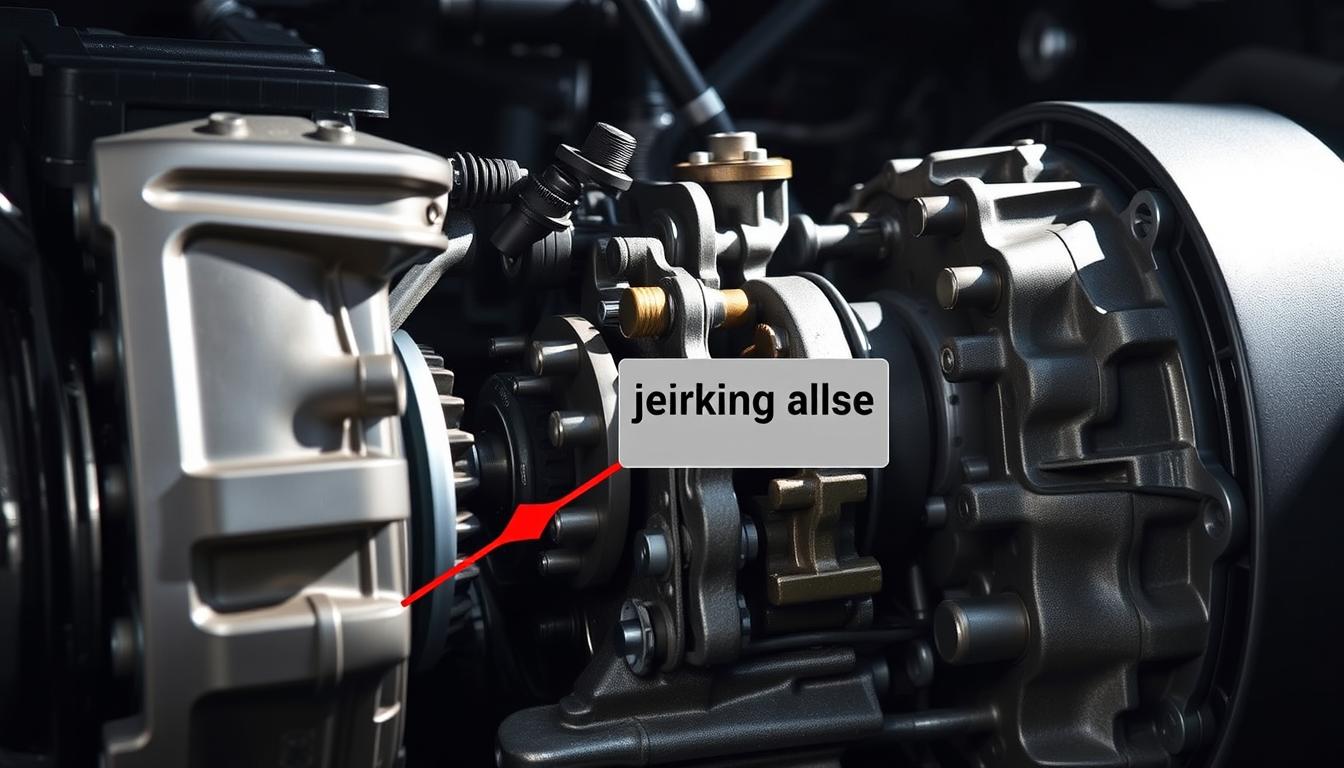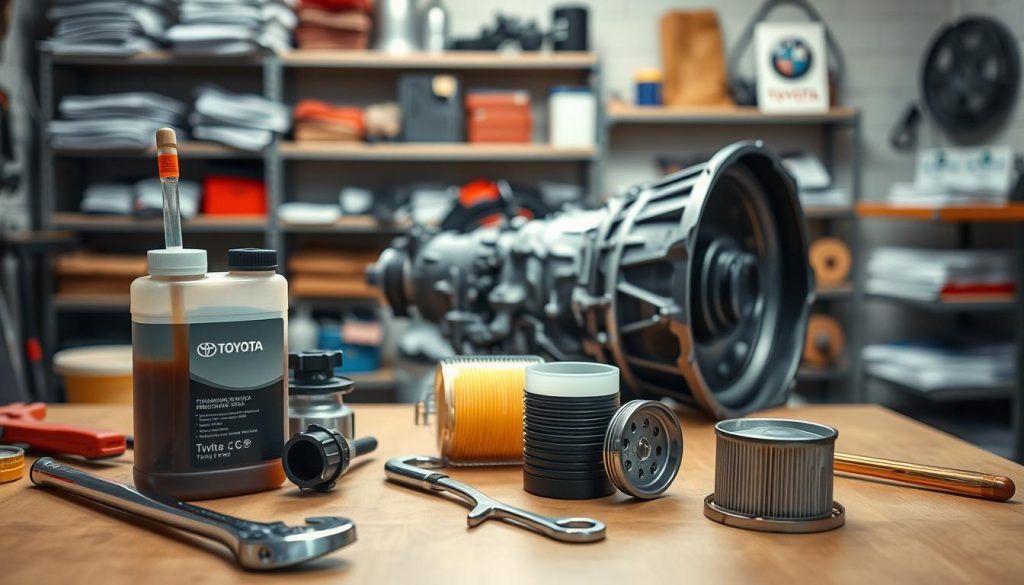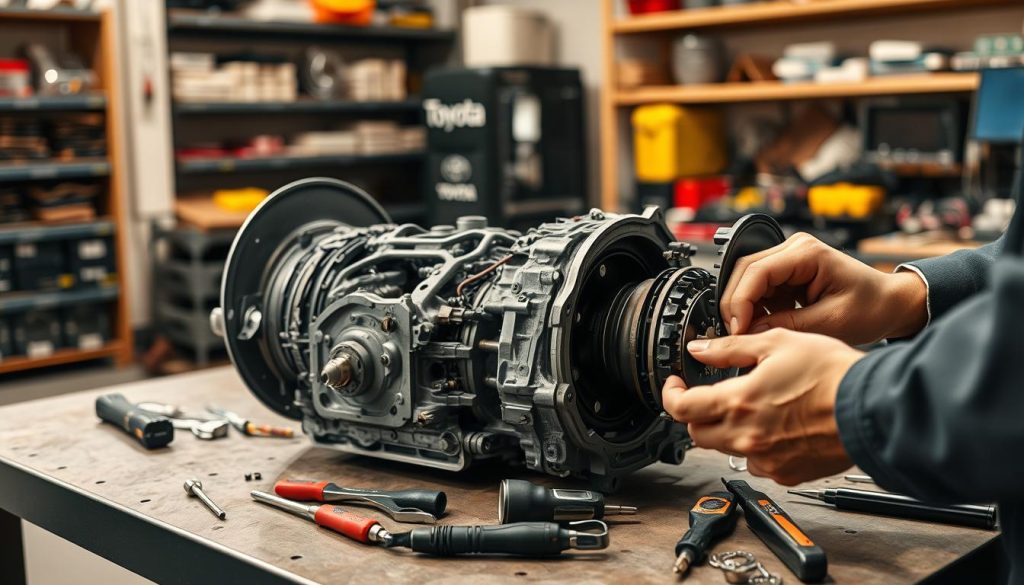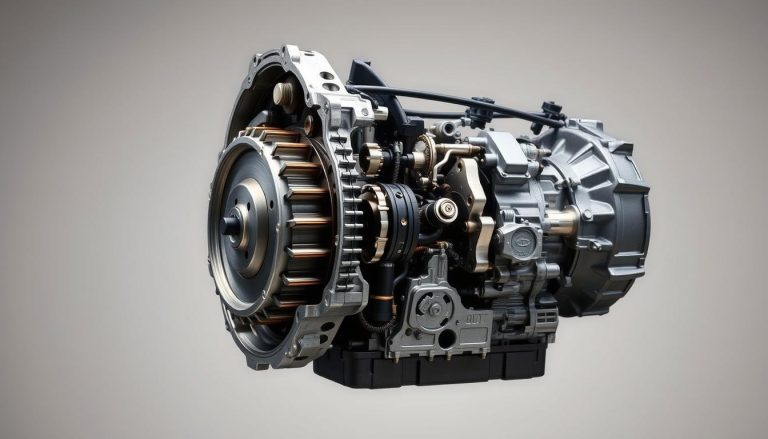Toyota Transmission Jerking: Causes & Fixes
Toyota transmission jerking can be very worrying for many owners. It’s when your car suddenly shifts gears or lurches. This problem is common in older Toyotas.
Many things can cause this issue. It might be due to low transmission fluid, vacuum problems, or faulty sensors. It’s important to check and fix these problems quickly to avoid bigger issues.
This guide will help you understand why your Toyota’s transmission jerks. It will also give you practical ways to fix it, so your car runs smoothly again.
Understanding the Toyota Transmission System
The Toyota transmission system is key to smooth driving. It turns the engine’s power into motion. Knowing how it works helps us see why Toyota transmission maintenance is so important. A well-kept transmission prevents many transmission problems Toyota owners face, making the car run better and last longer.
How Toyota Transmissions Work
Toyota transmissions are made for smooth gear changes. This is important for the car to run well. Automatic transmissions use a computer to shift gears without the driver noticing. Manual systems, on the other hand, can cause jerks if not used right. Keeping up with Toyota transmission maintenance helps avoid these issues.
Types of Transmissions in Toyota Vehicles
Toyota has many transmission types for different needs. These include:
- Automatic Transmissions: Easy to use and shift smoothly, thanks to the car’s computer.
- Manual Transmissions: Loved by those who enjoy driving more, for better control.
- Continuously Variable Transmissions (CVT): Offers a smooth ride and better gas mileage by adjusting to the drive.
| Transmission Type | Advantages | Common Issues |
|---|---|---|
| Automatic | Smooth driving, convenience | Overheating, sensor failures |
| Manual | Enhanced control, driving pleasure | Clutch wear, driver error |
| CVT | Fuel efficiency, smooth acceleration | Belt wear, software glitches |
Symptoms of Transmission Jerking in Toyota Vehicles
Transmission jerking in Toyota vehicles can really mess up your drive. It’s key to spot these signs early to prevent more damage and keep driving safe. Knowing the symptoms is the first step to fixing the problem.
Common Indicators
The main signs of transmission jerking are a thud or jerk when you accelerate or shift gears. This can make your car act weird, slow down power transfer, and feel unreliable. These signs mean you need to fix your transmission problems fast.
Impact of Jerking on Vehicle Performance
Transmission jerking not only messes with your car’s smoothness but also risks damage over time. If you keep ignoring it, it can wear out your car’s parts. This makes fixing the problem harder and can lead to bigger issues. So, it’s important to fix jerking symptoms quickly to keep your car running well.
Causes of Toyota Transmission Jerking
Understanding why Toyota transmissions jerk is key to fixing them. Many things can cause this problem, each needing its own fix. Let’s look at these causes closely.
Transmission Fluid Issues
Low or dirty transmission fluid is a big problem. It’s needed for smooth shifting. Without enough or clean fluid, shifting can become jerky.
Vacuum Modulator Valve Problems
Older Toyotas often have issues with the vacuum modulator valve. It controls gear timing. If it’s not working right, shifting can be harsh or erratic.
Faulty Sensors
Modern Toyotas rely on sensors for smooth shifting. A bad sensor can cause shifting problems. Fixing or replacing faulty sensors helps solve these issues.
Wear and Tear on Internal Components
Transmission parts like gears and clutches wear out over time. This makes shifting less smooth and can cause jerking. Keeping up with maintenance and replacing worn parts helps prevent this.
Transmission Fluid: The Silent Culprit
Keeping the transmission fluid clean and at the right level is key for Toyota transmissions to work well. If the fluid is dirty or low, it can cause the car to jerk when shifting gears. It’s important to check the fluid regularly as part of Toyota transmission service.
Importance of Keeping Transmission Fluid Clean
Clean transmission fluid makes shifting gears smooth and prevents overheating. It also helps cool and lubricate the transmission’s parts. A Toyota transmission specialist should flush the fluid regularly to keep it in top shape.
Signs of Contaminated or Low Transmission Fluid
- Discolored fluid (dark brown or black)
- An unusual or burnt smell
- Difficulty in shifting gears
- Visible leaks beneath the vehicle
How to Check and Replace Transmission Fluid
Checking and replacing transmission fluid is easy. You can do it yourself or ask a pro:
- Find the transmission dipstick while the engine is running.
- Pull out the dipstick, wipe it clean, and put it back in.
- Take out the dipstick again to see the fluid level and color.
- If the fluid is low or dirty, a Toyota transmission specialist can replace it with the right type.
Role of Vacuum Modulator Valves in Transmission Performance
Vacuum modulator valves are key in older Toyota models with automatic transmissions. They control gear shifts based on engine load. If they fail, it can cause transmission problems Toyota, making driving tough.
How Vacuum Modulator Valves Work
The vacuum modulator valve uses engine vacuum to control hydraulic pressure in the transmission. This ensures smooth shifts by adjusting gear shift timing based on engine load. Under heavy load, it increases pressure for firmer, later shifts.
Common Vacuum Modulator Valve Issues
Toyota transmission repair often deals with vacuum modulator valve problems. Common issues include:
- Leaks: Vacuum leaks upset the pressure balance needed for smooth transmission.
- Clogs: Debris and buildup can block the valve, causing erratic shifting.
- Wear and Tear: Over time, the valve and hoses can wear out, affecting performance.
Fixing Vacuum Modulator Valve Problems
Fixing vacuum modulator valve issues often means replacing worn parts. This includes checking and replacing hoses, cleaning out clogs, or installing a new valve. Keeping the valve in good shape ensures the right vacuum pressure. This fixes transmission problems Toyota and improves vehicle performance.
Sensors and Their Influence on Toyota Transmission Jerking
Modern Toyota cars use many sensors to control the transmission. These sensors check different things to make sure shifting gears is smooth and the car runs well. But, if sensors fail or send the wrong signals, the car might jerk.
Types of Sensors Related to Transmission
There are several key sensors for Toyota’s transmission. These include:
- Transmission Fluid Temperature Sensor: It watches the fluid’s temperature to avoid overheating.
- Throttle Position Sensor: It checks the throttle’s position to help with shifting gears.
- Vehicle Speed Sensor: It finds the car’s speed for accurate gear changes.
- Output Shaft Speed Sensor: It gives info on the output shaft’s speed for smooth shifting.
Diagnosing Sensor Issues
To find sensor problems, you need to read error codes from the car’s computer. This is done with special tools. These codes show which sensors are not working right.
| Symptom | Possible Sensor Issue |
|---|---|
| Transmission Jerking | Faulty Throttle Position Sensor |
| Delayed Shifts | Vehicle Speed Sensor Malfunction |
| Overheating | Transmission Fluid Temperature Sensor Issue |
Replacing Faulty Sensors
When sensors are found to be bad, they need to be replaced with genuine parts. Keeping up with Toyota’s maintenance helps sensors work right. This means less chance of the car jerking. Here’s what you need to do:
- Find the bad sensor with a Toyota transmission diagnostic.
- Buy the right OEM sensor part.
- Have a pro install it to avoid problems.
Having good sensors is key for the car’s transmission to work well and last long.
Impact of Overheating on Transmission Performance
Overheating can seriously damage Toyota transmissions if not fixed quickly. Knowing why it happens and how to stop it is key. This knowledge helps keep your Toyota’s transmission running smoothly.
Causes of Overheating in Toyota Transmissions
Several things can cause a Toyota transmission to overheat. Low fluid levels, driving too hard, and cooling system problems are common culprits. Catching these issues early can save you from expensive repairs.
Preventing Overheating Through Proper Maintenance
Regular care is the best way to avoid overheating. Check the fluid levels and make sure the cooling system works right. Following your car’s maintenance schedule helps prevent costly repairs.
Steps to Take When Transmission Overheats
If your transmission gets too hot, act fast. Stop driving and let it cool down. After it cools, check the fluid and look for any damage. If you find problems, get help from a Toyota expert to avoid more damage.
Importance of Regular Transmission Maintenance
Keeping up with regular Toyota transmission maintenance is key to your car’s long life and smooth running. It includes detailed checks and fluid changes. These steps help avoid problems like jerking or overheating.
Routine Maintenance Tips
To keep your Toyota transmission in top shape, follow these tips:
- Regularly check and change transmission fluid as your Toyota’s manual suggests.
- Look for any leaks or wear in the transmission system.
- Always use Toyota-approved transmission fluids and parts for services.
- Don’t forget to check the transmission filter regularly.
Benefits of Regularly Scheduled Maintenance
Regular Toyota transmission maintenance offers many advantages, including:
- Better vehicle performance and quicker response.
- Improved fuel efficiency.
- A longer-lasting transmission, saving you from expensive repairs.
- A higher resale value because of a well-kept transmission system.
Diagnosing Transmission Problems in Toyota Vehicles
Finding out what’s wrong with your Toyota’s transmission can be tricky. But, knowing how to do a Toyota transmission diagnostic makes it easier. Using advanced tools and special techniques helps find the problem accurately.
Tools and Techniques for Diagnosis
Diagnostic scanners are key in fixing Toyota transmissions. They connect to the car’s computer to find trouble codes. This helps spot the exact issue.
Testing the transmission by hand and using software to mimic driving conditions is also important. These steps help find the main problem. Together, they give you all the info you need to fix your Toyota’s transmission.
When to Seek Professional Help
If you can’t figure out your Toyota’s transmission problem, get help from a specialist. They know how to check your car thoroughly and find the right fixes. A Toyota transmission specialist will make sure your car runs well and lasts long.
Choosing the Right Auto Repair Shop for Transmission Issues
When you face Toyota transmission problems, picking a reliable repair shop is key. The right place should have qualities that show they care for your car.
What to Look for in a Repair Shop
First, check if the shop is ASE-certified. This means they meet high standards. It’s also important to find a shop that knows Toyota cars well. They’ll fix your car faster and better.
Look for positive reviews too. They tell you about the shop’s service quality.
Questions to Ask Your Mechanic
Before you decide, ask some important questions. Ask about the warranty for the repair. Knowing the repair time and cost helps avoid surprises.
Also, make sure your mechanic is open and clear. They should explain the repair process well. This shows they’re trustworthy.
Toyota Transmission Service: What to Expect
Knowing what happens in a Toyota transmission service is key to keeping your car in top shape. This service checks every part of the transmission. It makes sure everything works well and avoids future problems.
Components Checked During a Transmission Service
During a detailed Toyota transmission service, experts look at many important parts:
- Fluid level and quality
- Condition of the filter
- Clutch and gears
- Transmission control module
- Drive shafts and axles
Common Transmission Repairs and Their Costs
Even with regular care, some repairs might be needed. Here are common ones:
- Replacing worn parts like clutches and gears
- Flushing and refilling transmission fluid
- Recalibrating the transmission control module
- Repairing or replacing vacuum modulator valves
The price of these fixes can change a lot. For example:
| Type of Repair | Estimated Cost |
|---|---|
| Transmission Fluid Flush | $100 – $300 |
| Recalibration | $200 – $500 |
| Replacing Worn Parts | $500 – $1,500 |
| Complete Rebuild | $2,000 – $4,000 |
Regular Toyota transmission maintenance can save you money. It keeps your car running smoothly and avoids expensive repairs.
Common Transmission Repair Solutions
Dealing with Toyota transmission problems can be tough. You might face small issues or big malfunctions. Knowing the repair options can help you decide what to do.
Simple Fixes vs. Extensive Repairs
Sometimes, fixing Toyota transmission problems is easy. You might just need to replace sensors or change the fluid. These fixes are quick and cheap.
But, if the problem is bigger, like needing to replace parts inside or the whole transmission, it’s more serious. These repairs take longer and cost more.
Cost Implications of Different Repairs
The price of fixing a Toyota transmission depends on the problem. Small fixes, like adjusting fluid levels or replacing sensors, are cheaper. But, bigger repairs, like rebuilding the transmission, cost a lot more.
It’s smart to get a clear price estimate before starting any big work. This way, you know what to expect.
Timeframes for Various Repairs
How long it takes to fix a Toyota transmission varies. Small fixes might take just a few hours. But, bigger repairs could take days.
Knowing how long a repair will take helps you plan. It lets you avoid big disruptions to your life.
No matter the size of the problem, fixing it fast is key. Catching small issues early can save you from bigger, more expensive problems. Always get professional advice and a detailed quote before starting any repair.
Toyota Transmission Jerking: Causes & Fixes
Toyota transmission jerking can be a big problem. It might mean there’s something wrong that needs fixing. Knowing what causes it and how to fix it can help car owners solve the issue quickly.
Recap of Common Causes
Toyota transmission jerking often comes from a few main issues. It’s important to know these causes to start the right repairs:
- Low or dirty transmission fluid: Bad or not enough fluid can make shifting hard.
- Faulty vacuum modulator valves: These parts control pressure; problems here can mess up how the transmission works.
- Worn sensors: Sensors are key for the transmission to work right; when they wear out, it affects how well it operates.
- General wear and tear: As time goes on, parts inside can get worn out, causing jerking and shifting issues.
Effective Fixes for Transmission Jerking
To fix Toyota transmission jerking, you need to target the right repairs. Here are some steps to make your transmission work smoothly again:
- Replace or replenish transmission fluid: Keeping an eye on and changing the fluid regularly is important for its quality and level.
- Repair or replace vacuum modulator valves: Fixing these valves can solve problems with pressure control.
- Diagnose and replace faulty sensors: Sensors need to work right for the transmission to function properly.
- Inspect and repair internal components: Fixing wear and tear through professional repairs can help your transmission last longer and work better.
Regular maintenance and quick action are important to avoid Toyota transmission jerking. They help keep your car running well over time.
Conclusion
Dealing with Toyota transmission jerking can be a concerning challenge. But, understanding its causes and recognizing early symptoms can lead to effective solutions. This article has shown the importance of clean transmission fluid, proper vacuum modulator valve function, and addressing sensor issues.
Regular maintenance and timely repairs are key to preventing transmission problems. By sticking to routine check-ups and fixing any signs of transmission jerking quickly, you can ensure a smoother ride. Also, getting help from qualified professionals for diagnostics and repairs is important.
Addressing Toyota transmission jerking needs a proactive maintenance approach and understanding of the system’s intricacies. Keeping up with possible issues and acting fast when they happen ensures your Toyota stays reliable and efficient. By following these guidelines, you can improve your driving experience and protect your vehicle’s performance for a long time.
FAQ
What causes Toyota transmission jerking?
Toyota transmission jerking can be caused by several issues. These include low or dirty transmission fluid, faulty vacuum modulator valves, and worn sensors. Also, general wear and tear on internal components can cause it.
How do Toyota transmissions work?
Toyota transmissions convert the engine’s power into motion. They ensure smooth and seamless gear transitions. Automatic transmissions are managed by a computer that controls gear shifts. Manual systems require driver input.
What types of transmissions are used in Toyota vehicles?
Toyota vehicles use different types of transmissions. These include conventional automatic transmissions, continuously variable transmissions (CVT), and manual transmissions. Each type meets different driving preferences and requirements.
What are the common indicators of transmission jerking in Toyota vehicles?
Common indicators include a noticeable thud or jerk when accelerating or shifting gears. You might also notice delayed response in power transfer and erratic vehicle behavior.
How does transmission jerking impact vehicle performance?
Transmission jerking can lead to erratic vehicle behavior and a diminished driving experience. It can also increase wear and tear on the transmission system. This can affect overall vehicle performance.
What role does transmission fluid play in the smooth operation of Toyota transmissions?
Transmission fluid is key for maintaining hydraulic pressure for smooth gear shifts. Clean and adequate fluid levels ensure optimal performance. Dirty or low fluid can cause jerking and other issues.
How can I check and replace the transmission fluid in my Toyota?
To check transmission fluid, make sure the vehicle is on a level surface and the engine is warm. Use the dipstick to verify fluid levels and condition. If it’s low or dirty, replace it with new, manufacturer-approved fluid.
What problems can arise with vacuum modulator valves in Toyota vehicles?
Vacuum modulator valve issues, common in older models, can lead to incorrect shifting points and jerking. Problems include leaks, clogs, or wear. These often require inspection and replacement of the valve or connecting hoses.
How do sensors influence Toyota transmission jerking?
Sensors in modern Toyota vehicles manage transmission functions like gear shifting based on driving conditions. Faulty sensors can misread data, causing transmission jerking. Diagnosing and replacing faulty sensors with OEM parts is key for resolving these issues.
What are the causes and prevention methods for overheating in Toyota transmissions?
Overheating can be caused by low transmission fluid, excessive load driving, and faulty cooling systems. Preventive maintenance, like regular fluid checks and ensuring a functioning cooling system, can help avoid overheating. If overheating occurs, stop driving and seek professional assessment.
How important is regular transmission maintenance for Toyota vehicles?
Regular transmission maintenance is vital for longevity and reliability. It involves routine checks and fluid changes. Benefits include better performance, higher resale value, and reduced risk of transmission failure. Follow the manufacturer’s guidelines for optimal results.
What tools and techniques are used for diagnosing transmission problems in Toyota vehicles?
Diagnosing transmission issues involves using diagnostic scanners to read trouble codes from the vehicle’s computer. Manual testing of transmission responsiveness and diagnostic software to simulate driving conditions are also used. Consulting a Toyota transmission specialist is advisable for complex problems.
What should I look for in an auto repair shop for Toyota transmission issues?
Look for shops with ASE certification, experience with Toyota models, and positive customer reviews. Ask about warranty coverage, repair timeframes, and costs. Transparent communication and thorough explanations are indicators of a trustworthy service provider.
What can I expect during a typical Toyota transmission service?
A technician will inspect fluid levels and quality, filter condition, and mechanical parts like the clutch and gears. Common repairs may include replacing worn parts, fluid flushes, or recalibrating the transmission control module. Costs and repair times vary based on the extent of the issue.
What are some common transmission repair solutions for Toyota vehicles?
Repair solutions range from simple fixes like sensor replacement or fluid changes to extensive repairs like overhauls or component replacements. Costs and timeframes vary; get a detailed quote and timeline from your service provider before proceeding with significant repairs.











